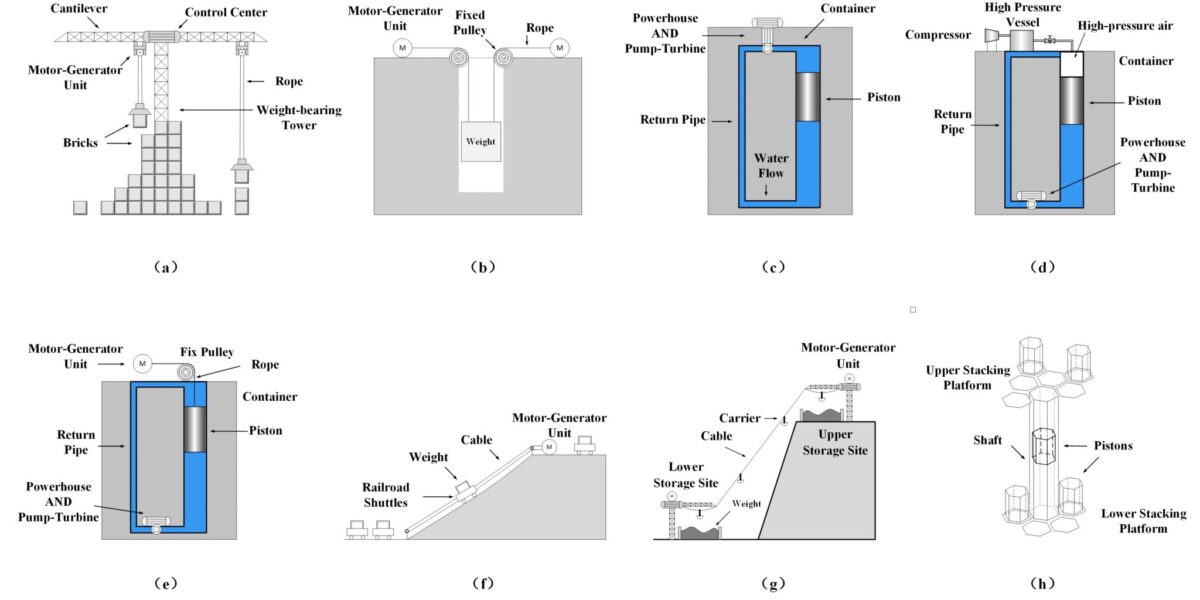From pv magazine Global
Researchers in China have proposed to hybridise gravity energy storage (GES) with power-based storage solutions such as batteries and supercapacitors, which they say may offer the advantages of all these technologies in a single solution.
The scientists dubbed the proposed combination hybrid solid gravity energy storage system (HGES) and said this technology may find applications in both distribution and transmission grids, while solving the technical problems of GES by avoiding repeated starting and stopping of the motor, which could cause losses and significant fluctuations in output power. “Various possible system structure schemes for the proposed HGES have been investigated,” the research’s corresponding author, Wenxuan Tong, told pv magazine.
In the proposed system configuration, the GES unit is coupled with a power-based storage module. The GES unit is used to absorb excess power from the grid or release power when demand in the grid exceeds production, while the power-based module provides rated power in order to compensate for the fluctuating active power during the operation of the GES system.
The composition of the HGES depends on the type of motor used, the electric drive equipment, the grid access method, and the power-based energy storage access position. “From the perspective of system structural composition, HGES can be divided into mechanical systems, motors, electrical drive systems, grid access systems, and power-based energy storage systems,” the scientists explained.
They also explained that the proper functioning of the HGES system relies heavily on the control of power electronics, noting that different control strategies should be applied in different situations to achieve the best-integrated control effect. Furthermore, they said control strategies should also be implemented at the single-type energy storage system and hybrid energy storage system level.
The academics conducted a series of simulations via Simulink (MATLAB) and found that the proposed system is able to meet their theoretical expectations. “The power-based energy storage in the hybrid gravity storage system can well suppress the inherent power fluctuation problem of GES under the rectangular-based compensation strategy,” they emphasised. “The response speed of the HGES is improved by 1 to 2 orders of magnitude compared to the single GES system.”
Furthermore, they claim the system may achieve an efficiency of over 80%, especially if applied in distribution and transmission grids. “It is an ideal energy storage system without obvious performance drawbacks and will be expected to provide critical technical support for developing renewable energy power systems,” they concluded.
Their findings are presented in the paper “The structure and control strategies of hybrid solid gravity energy storage system,” published in the Journal of Energy Storage. The research team comprises scientists from the North China Electric Power University and the State Grid Smart Grid Research Institute Co., Ltd.
This content is protected by copyright and may not be reused. If you want to cooperate with us and would like to reuse some of our content, please contact: editors@pv-magazine.com.









By submitting this form you agree to pv magazine using your data for the purposes of publishing your comment.
Your personal data will only be disclosed or otherwise transmitted to third parties for the purposes of spam filtering or if this is necessary for technical maintenance of the website. Any other transfer to third parties will not take place unless this is justified on the basis of applicable data protection regulations or if pv magazine is legally obliged to do so.
You may revoke this consent at any time with effect for the future, in which case your personal data will be deleted immediately. Otherwise, your data will be deleted if pv magazine has processed your request or the purpose of data storage is fulfilled.
Further information on data privacy can be found in our Data Protection Policy.